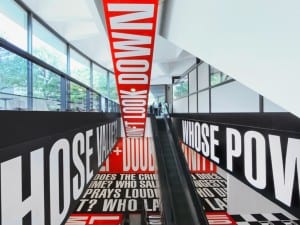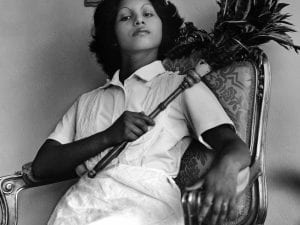The 13th Biennale de Lyon, La Vie Moderne, brings together artists from 28 different countries who explore the contradictory character of contemporary culture in varied regions of the world. For the 2015 edition, Thierry Raspail, Artistic Director of the Biennale, invited guest curator Ralph Rugoff to work with him on the first instalment of the theme of ‘modern’. The projects featured in this year’s event address the way in which multifarious legacies of the ‘modern’ era continue to colour and shape our perceptions. Participating artists include Michael Armitage, Ed Ruscha, Kader Attia, Nina Beier, Cyprien Gaillard, Camille Henrot, and David Shrigley. We speak with Raspail about his understanding of the term ‘modern’, how it infiltrates our everyday lives, and how it inspires contemporary practitioners today.
A: ‘Modern’ is a vague term with all sorts of meanings in a historical sense. What do you define as modern?
TR: 30 years ago – in the mid-80s more or less – the modern was proclaimed outdated, finished. We were convinced we were entering the post-modern: the era of the end of history, of antagonisms and grand narratives. But ‘modern’ has a long history of its own, with multiple time frames; like ‘global’ and ‘transmission’ it is a highly flexible term, whose meaning varies with the context. What’s important for me is that the curators I invite to the Biennale should be able to offer their own interpretations of the keyword I’ve chosen. For me, modern means the simultaneous intermingling of the time frames of global creativity; a creativity now converging from all over, from cultural areas, which so far have been absent from the international scene and are – whatever their historical traditions – contributing to a redefinition of the contemporary. Modern is the contemporary ‘condition’ now made up of all the historical traditions that had not previously been invited in by Western modernity; traditions that now not only embrace that modernity, but are becoming a part of it and expanding it. Up until now we’ve been thinking of the modern in terms of succession and of periods. Today what we are experiencing is a constant overlaying of all these interconnected modernities; a new modern intensified by today’s information flows. A new global visual order, you might say.
A: Given the enormous number of biennales internationally, what is there about the Biennale de Lyon that sets it apart?
TR: In Lyon there’s a keyword that works as a main strand for three biennials, interpreted by three consecutive curators. Modern is coming up for the first time this year, but it will be running through until 2019. There’s a single artistic director – the director of the Museum of Contemporary Art – who sees the Biennale de Lyon in terms of continuity: like a kind of programme. The curator is chosen to fit the keyword, not – for example – because of his or her star status. And through its Veduta and Resonance platforms the Biennale engages with the very local (and the amateur) as well as the very global current art scene.
A: The Biennale de Lyon places an emphasis on emerging artists in local venues as well as exhibiting work by internationally acclaimed names. How has the region benefited culturally as a result?
TR: The Biennale was created six years after the Museum of Contemporary Art, of which it’s a kind of extension. These are the two facets of a single project overseen by a single artistic director. So there’s a permanent programme accompanied by network of art centres. The Biennale has had a clear impact both culturally and economically: it has helped expand the local audience for art considerably and make art a part of everyday life; and of course it has had an effect on art output, on collectors, and so on. It has also put Lyon on the map, right in the centre of a number of international biennales.
A: As director of the Hayward Gallery, Ralph Rugoff has organised shows that encourage active audience participation and debate about contemporary issues. What prompted you to invite him to curate this year’s event?
TR: I was convinced by the Hayward’s programme, together with Ralph Rugoff’s take on the current scene and his sense of space. A good exhibition is the result of a subtle alchemy between scale, space and artworks. Ralph’s work at the Hayward is remarkable, especially as the gallery doesn’t lend itself to elegant handling. What I needed to kickstart the Modern trilogy was a curator/ historian – and a pragmatist with a sense of humour.
A: The Biennale offers a real variety of styles and media. Which artists are you most looking forward to seeing on show?
TR: It’s very hard to make judgements about artworks. Modern Life – Ralph’s very simple but very effective title for his exhibition – expresses the range of possibilities. It’s both accessible and mysterious, like a film title. Like Yoko Ono’s Instructions, it’s completely new and at the same time seems to have always been there. But to come back to your question, what I see as significant is the gap between the artists, eg. Ed Ruscha (who isn’t seen in biennales) and Hicham Berrada.
A: Thanks to the Veduta programme, anyone with an interest in art can enjoy it at an accessible level, regardless of experience or background. How has this developed over the years?
TR: The Veduta platform’s title is borrowed from those Western Renaissance painters who opened a window onto a broader view of things. Veduta began simply with artists, art history and the Museum of Contemporary Art collection. Since George Brecht, George Maciunas and Yoko Ono invented the event, everyone can do it and interpret it. What Beuys says about each of us as a creator, and the implications of Robert Filliou’s ‘permanent creation’, are within everybody’s reach. These are simple ideas and fresh paradigms everyone can make use of. This was the beginning of Veduta: interpretation. Veduta comes to agreements with different municipalities in the region and works with communities which interpret and in turn become curators, cultural mediators, exhibition teams and ambassadors. We go door to door in apartment blocks, we offer quick and surprising encounters with artworks in bus shelters. It’s a school for art lovers that includes residencies, artists on site, workshops in peculiar venues exhibitions all over the place, museum collections, art tours in stores and works on show in people’s apartments, and in 2015, 10 presentations of works from the MAC collection all around the Lyon metropolis. And all this hand in hand with a public which, in theory, knows nothing about contemporary art.
Biennale de Lyon, La Vie Moderne, until 3 January 2016, various venues across Lyon.
Further details can be found at www.labiennaledelyon.com.
Follow us on Twitter @AestheticaMag for the latest news in contemporary art and culture.
Credits
1. WILCOX T.J, In the Air 2013, digital video © Bill Jacobson. Courtesy of the Biennale de Lyon.





